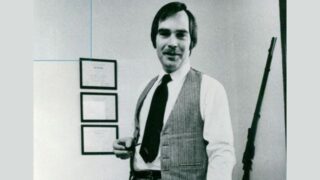Juan Percowicz, an accountant with a passion for philosophy, established in 1983 a school that attracted intellectuals, doctors, and artists.
by Massimo Introvigne
Article 2 of 5. Read article 1.


Spending 18 days in jail in a cell with another nine prisoners, sleeping on a mattress on the floor, had clearly taken a toll on the health of Juan Percowicz, who will turn 85 in June. The man described by the media as the inventor of new brainwashing techniques and the mastermind of a cult hiding an international prostitution ring looked exactly like the person he was supposed to be according to his identity documents: an old business consultant, who lives in a comfortable but not luxurious apartment in a good neighborhood of Buenos Aires, assisted by a female caretaker (who is not young either).
Percowicz was born in Buenos Aires on June 29, 1938, from Polish-Ukrainian Jewish parents. By his own account, he was a mediocre student, since from his early years he was as interested in philosophers and the great figures of world literature as his friends were in Argentinian football players, which somewhat distracted him from the regular school curriculum. He was good with numbers, though, and eventually graduated from the School of Economy of the University of Buenos Aires as a certified public accountant with a degree in business administration.
He never made it to the Olympus of the high-profile accounting firms, but he had a prosperous business, which allowed him free time to keep studying philosophy and opened to him the doors of the GEBA, the Gymnastic and Fencing Club of Buenos Aires, regarded by many as the finest club in the city. There, a man called Dante Norberto Parandelli was offering yoga classes. A look at the books written by him helps dispelling a misunderstanding about the word “yoga.” When they raided the BAYS, the police were surprised that they did not find yoga mats at a place called a school of yoga. But in fact in its millennia-old history in India, yoga has always been a philosophy before being a system of physical exercises. Parandelli taught both, although some of his books deal with the philosophical part only, and it was yoga as a philosophy (Raja Yoga) that mostly interested Percowicz.
From 1971, Percowicz took classes with Parandelli at GEBA, and private lessons as well. Later, when the first criminal case against the BAYS started, Parandelli tried to downplay his relationship with Percowicz. While stating that Parandelli only helped him in the first part of his philosophical itinerary, Percowicz remains grateful to him. In one of the few books he published, “Los cinco magos de la Notre-Dame” (The Five Magicians of Notre Dame), co-authored with Susana Franca and César Pallotta in 1991, Percowicz included Dante Parandelli (Etnad, or Dante spelled backwards) and the mysterious man Parandelli himself mentioned as his own master, Durante (Etnarud), among the five magicians who meet every hundred years above Paris’ cathedral to work on behalf of humanity.


To become the man known to his pupils as the founder and leader of BAYS, Percowicz did not rely on groups and schools. He spent more than ten years avidly reading Western and Eastern philosophers and esoteric masters, from Plato to Walt Whitman, and from Krishnamurti and Yogananda to Spinoza. His list of preferred authors, that he would later recommend to his students, included Hindu masters such as Vivekananda and Western esoteric luminaries such as Helena Blavatsky, Charles Webster Leadbeater, Mabel Collins, and Paul Brunton, but also Nietzsche, Goethe, and Hermann Hesse. While the catalog looks eclectic, talking with both Percowicz and his students the importance of one particular tradition emerges, the teachings of Gurdjieff as presented by his independent disciple Ouspensky. This does not mean that Ouspensky’s book “In Search of the Miraculous: Fragments of an Unknown Teaching,” with which all BAYS students are familiar, is a textbook or a manual for them. They just take from it some basic ideas, of which they find confirmations in other texts and traditions.
In 1983, three ladies called in the school the “Three Bs”—Bibí Lefèvre de Giglioli, Beba Fernández de Morales, and Beatriz Vigil de Sosa Molina—asked Percowicz to teach Raja Yoga to them. This was the origin of what later became the BAYS. It was always a group of friends, which never exceeded 300 members, with a larger circle of perhaps 1,000 who occasionally attended events and lectures. The lectures attracted, among others, distinguished members of the artistic and musical community, including soprano Verónica Iácono, the late violin player, composer, and director Rubén González, who had an important career in the United States, Mariano Krawczyk (Mariano Krauz), regarded as one of the best oboists in the world, and composer Susana Mendelievich. They expressed the ideas of the school in musical compositions that caught the attention, among others, of Spanish opera singer Plácido Domingo, who became their friend of many years (although, after the 2022 raid, he also tried to distance himself from the group). Artists of a different field also joined: Carlos Barragán went on to win the 1997 World Championships of Stage Magic in Dresden, Germany, with a team entirely composed of BAYS members.


My interviewees commented that the school also attracted a large number of members from two minorities, Jews and homosexuals. Some lamented that in the first and second criminal cases some police officers insulted them with anti-Semitic and homophobic comments. They all maintain that anti-Semitism was a component of the opposition, and in the early days the fact that the school welcomed homosexuals also raised eyebrows.
Meanwhile, the BAYS was looking for a permanent home. In 1990, a group of students teamed up with Percowicz and hired architects from the same school to build a ten-story building on Estado de Israel Avenue in Villa Crespo. Percowicz would own a café where courses would be held, on the ground floor, and the other members of the group would own the flats on the other floors. In order to speed up the construction, and to allow the rest of the group to finance their share of the work in instalments, Juan Percowicz paid his full share in advance in exchange for the café being inaugurated earlier. The inauguration took place in 1992. The construction of the building was halted in 1994 due to the first criminal proceedings, and restarted in 1995. Soon after, the owners of the brand-new building had their own roof over their heads.


In 1993, the BAYS had also tried to create a legal structure overseeing its activity, the Fundación Escuela de Yoga de Buenos Aires, but it was put into receivership in 1994 at the time of the first case and liquidated in 2023. The school per se continued to function without a legal organization. Members of the BAYS created businesses that were not part of the school but applied some of its ideas to different fields and employed mostly fellow students. B.A. Group offered coaching through both courses and private lessons and had among its clients some large Buenos Aires institutions and businesses—including, ironically, the news group INFOBAE, which would later publish some of the most vitriolic attacks against the BAYS. Aznarez Propiedades was a real estate agency—and some students also worked at Salum Propiedades, whose owner was the brother of anti-cultist Pablo Salum, German Javier Salum, who had left the BAYS but unlike his brother had remained a friend.
CMI Abasto was called within BAYS a “clinic” but was more exactly a center with offices of several doctors and psychologists, not all of them members of the school. There, one of the services offered were the “dream cures” (curas de sueño) where stressed patients were induced to sleep for longer hours than usual for relaxation purposes. There was also a law firm led by a female student, Susana Barneix, who is an attorney, and several companies in the United States, where the school had a few members. In the court cases an informal “bank” was also mentioned, which in fact was a common fund where those who lived in the State of Israel Avenue building and others may contribute to common expenses and borrow money when needed. As it happens with many other Argentinians, BAYS students did not trust banks, and kept significant quantities of money, including US dollars regarded as safer than local currency, at home.
I interviewed those responsible for these businesses and BAYS students who worked there. They told me that most clients were not members of BAYS, and they never received a proposal to join the school. Before 2022, Aznarez sold dozens of properties, only four of them to students of the school. B.A. had no clients at all that were part of BAYS. CMI Abasto had BAYS patients, including Juan Percowicz, but many were not part of the school and had not even heard about it. They all denied that the businesses were used to attract new members of the school. In fact, in 1999 the BAYS had decided no longer to accept new members, although those who were once students and were no longer attending the lessons were always welcome to return. While the first court case had an influence on this decision, it was also taken because the number of senior students who could serve as mentors to the new members was limited, and did not allow for further expansion. Exceptions were made for a small number (less than ten) of children of the existing students. At the time of the 2022 raid, members were probably 168, with a median age of 58—the list I consulted has been reconstructed without the help of the original records, which had been seized and not returned to the BAYS.


At the center of the life of the school were the classes given twice a week in the cafeteria, personally by Juan Percowicz in the early years and mostly by senior students more recently. Although classes were not offered after the 2022 raid, the cafeteria keeps what looks like a stage with musical instruments, and shows and performances were offered before the lectures. As distinguished from the classes, there were ceremonies and rituals organized by a group of women, humorously called the “Ghostbusters” after the 1984 American comedy movie. While the judge in the court case suspected these were rituals of “black magic” or “sexual orgies,” I interviewed some of the Ghostbusters themselves, who insisted that they consisted in lighting candles and ritually cleansing apartments with vinegar and the medicinal herb known as rue (ruta graveolens), which is often used in ritual magic. Students did not necessarily believe in magic, the Ghostbusters explained, but did find it had a positive psychological effect on those participating in the rituals.









